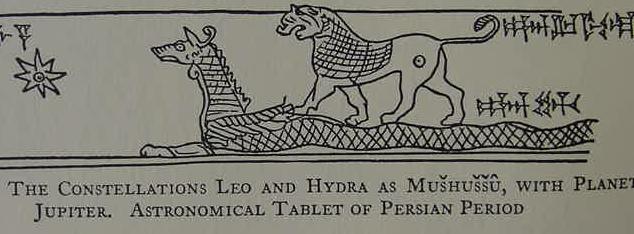Below is an image of Marduk, the supreme god of Babylon, at his feet is the Mushhushshu Serpent-dragon, which has become associated with him, as he overpowered it when he defeated Tiamat the female personfication of the salty sea or ocean, mother of the gods, who sought to destroy the land-dwelling gods until killed by Marduk. In this myth the Serpent-dragon was a creature of Tiamat's (for the image cf. p. 301. S. H. Langdon. 1931 cited above). This drawing is after a 9th century BCE Babylonian cylinder seal. The Assyrians later declared their God Asshur as the god who defeated Tiamat, and Marduk's serpent-dragon was portrayed as accompanying Asshur. Marduk's robe is the heavenly night sky with all its stars. he was also called "the son ofthe Sun," "the Sun" and "bull-calf of the Sun" (Babylonian amar-utu).
Below, an Assyrian seal showing the god Nabu with crescent moon above his head and the supreme god Asshur with winged sun disc before him, both standing on horned Mushhushshu sepent-dragons borrowed from Babylonian myths. Nabu is the scribe god and he was also associated with irrigation and agriculture. The serpent-dragon in earliest myths was a vegetation deity, and associated perhaps with the annual cycle of life and death manifested in crops, which came to also be associated with a resurrected Tammuz/Dumuzi and Ningishzida (for the illustration cf. p. 159. Langdon, 1931 cited above)
